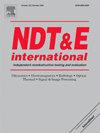Active compensation method for restraining high-speed MFL signals distortion based on atypical synthesized magnetic field
IF 4.5
2区 材料科学
Q1 MATERIALS SCIENCE, CHARACTERIZATION & TESTING
引用次数: 0
Abstract
Magnetic flux leakage (MFL) detection is attaching importance in pipeline non-destructive detection. However, the MFL signals will be distorted due to the speed effect, resulting in a low detection accuracy. Reducing the detection speed and algorithmic compensation for the offline data are the two main current methods, but these methods reduce the detection efficiency and require a large amount of training data. In this article, an active compensation method for restraining high-speed MFL signals distortion based on atypical synthesized magnetic field (ASMF) is proposed to solve above problems. ASMF is a magnetic field with the asymmetric double peaks, whose shape and intensity can be complementary to the distorted MFL signals. First, the dynamic circuit theory is introduced to elaborate the speed effect mechanism. Second, the ASMF method is proposed to compensate the distorted MFL signals according to the speed. Furthermore, the target and non-target magnetic fields are corrected to satisfy the MFL detection under different lift-off. The relative optimum position between the main peak and side peak is studied to further reduce the MFL signals distortion. Third, the active compensation circuit system is developed, which can measure the speed and lift-off in real time to adjust ASMF and compensate the distorted MFL signals. Finally, the MFL detection experiments under different speed, lift-off, and defect are performed to verify the effectiveness of the proposed method. Results show that the minimum relative error of the defect depth detection using the compensated MFL signals can reach -2.33%, and Type A uncertainty can be kept within 0.0346 mm.
基于非典型合成磁场抑制高速磁漏信号失真的主动补偿方法
漏磁检测在管道无损检测中占有重要地位。然而,由于速度效应的影响,MFL信号会发生畸变,导致检测精度较低。降低检测速度和对离线数据进行算法补偿是目前主要的两种方法,但这些方法降低了检测效率,并且需要大量的训练数据。针对上述问题,本文提出了一种基于非典型合成磁场(ASMF)的抑制高速磁通信号失真的主动补偿方法。ASMF是一种具有非对称双峰的磁场,其形状和强度可以与失真的MFL信号互补。首先,引入动态电路理论,阐述了速度效应机理。其次,提出了一种基于速度补偿失真的ASMF方法。此外,还对目标磁场和非目标磁场进行了校正,以满足不同发射高度下的磁漏检测。研究了主峰和副峰之间的相对最佳位置,进一步减小了漏磁信号的失真。第三,开发了有源补偿电路系统,实时测量速度和升力,对ASMF进行调整,补偿失真的MFL信号。最后,进行了不同速度、起飞和缺陷条件下的MFL检测实验,验证了该方法的有效性。结果表明,利用补偿后的磁漏信号进行缺陷深度检测的最小相对误差可达-2.33%,A型不确定度UAm可保持在0.0346 mm以内。
本文章由计算机程序翻译,如有差异,请以英文原文为准。
求助全文
约1分钟内获得全文
求助全文
来源期刊

Ndt & E International
工程技术-材料科学:表征与测试
CiteScore
7.20
自引率
9.50%
发文量
121
审稿时长
55 days
期刊介绍:
NDT&E international publishes peer-reviewed results of original research and development in all categories of the fields of nondestructive testing and evaluation including ultrasonics, electromagnetics, radiography, optical and thermal methods. In addition to traditional NDE topics, the emerging technology area of inspection of civil structures and materials is also emphasized. The journal publishes original papers on research and development of new inspection techniques and methods, as well as on novel and innovative applications of established methods. Papers on NDE sensors and their applications both for inspection and process control, as well as papers describing novel NDE systems for structural health monitoring and their performance in industrial settings are also considered. Other regular features include international news, new equipment and a calendar of forthcoming worldwide meetings. This journal is listed in Current Contents.
 求助内容:
求助内容: 应助结果提醒方式:
应助结果提醒方式:


